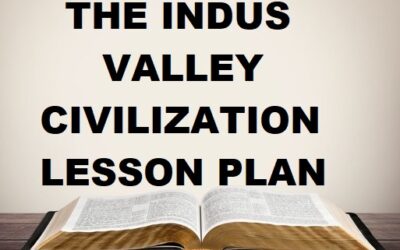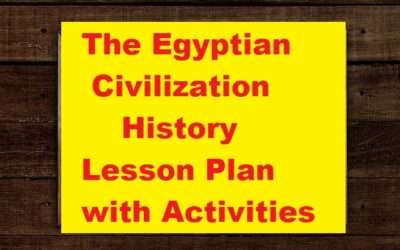The Early Vedic Civilization – History Lesson Plan with Activities
The Early Vedic Civilization Lesson Plan acquaints students with one of the most important periods in ancient Indian history. It deals with the people of the Vedic era, their way of life, faith, and contributions towards the development of Indian society.
Additionally, The Early Vedic Civilization Lesson Plan enables students to learn about how early societies developed through agriculture, religion, and administration. With interactive discussions and hands-on activities, students actively experience the Rigvedic texts and analyze their significance in history.
Additionally, the lesson plan links previous traditions with modern practices, hence making learning relevant and applicable. It promotes critical thinking by enabling students to review how the social framework, economic setup, and culture defined early Indian life.
Besides, The Early Vedic Civilization Lesson Plan provides instructors with objective learning strategies, instructional materials, and assessment tools that streamline classroom instruction.
In the end, this plan makes history come alive as a learning adventure of concepts, accomplishments, and cultural origin.
Class VI History Chapter 7 Lesson Plan: Ashoka, The Emperor Who Gave Up War
The Early Vedic Civilization – History Lesson Plan with Activities
1. General Information
Subject: History / Social Science
Class: VI–VIII
Topic: The Early Vedic Civilization
Duration: 45–50 minutes
Teaching Aids: Smartboard, Vedic hymn extracts, chart illustrating Aryan migration, map of the Indian subcontinent, PPT or flashcards
2. Learning Objectives
Upon completion of this lesson, students will be able to:
Explain the origin and expansion of the Aryans in India.
Describe the key characteristics of the Early Vedic society.
Identify the function of Rigveda as a source of information.
Compare Early Vedic life with subsequent phases of Indian civilization.
Develop appreciation for ancient Indian culture and traditions.
3. Introduction (5 minutes)
Teacher Activity:
Start with an interesting question: “Have you ever wondered who wrote the world’s earliest hymns?”
Show a map illustrating the migration of the Aryans into India.
Introduce the subject and write on the blackboard: “The Early Vedic Civilization.”
Student Activity:
Look at the map and answer questions regarding migration and settlements.
Transition:
“Let’s now see how the Aryans lived, what they believed, and how their lifestyle influenced early Indian culture.”
4. Presentation (20 minutes)
Teacher Activity:
Describe important facts using visuals and discussion:
Time Period: 1500 BCE – 1000 BCE
Sources: The Rigveda
Society: Patriarchal, based on joint families
Economy: Agriculture and cattle rearing
Religion: Nature worship and simple rituals
Political Life: Tribal councils such as Sabha and Samiti
Teaching Aids:
PPT slides or diagram illustrating gods such as Indra and Agni.
Optional audio clip of a Rigvedic hymn.
Student Activity:
Take notes, pose questions, and engage in discussions.
5. Discussion / Activity (10 minutes)
Group Activity:
Split students into groups and give each a theme (Religion, Society, Economy, etc.).
Ask them to prepare a brief presentation or chart on their given theme.
Interactive Question:
What commonalities are there between Early Vedic society and society today?
6. Evaluation (5 minutes)
Oral Questions:
What is the primary source of information on the Early Vedic period?
Mention two gods who were worshipped during this period.
What were Sabha and Samiti?
In what ways was the Early Vedic economy different from the contemporary economy?
Written Assessment:
Short quiz or worksheet on major points.
Worksheet: Early Vedic Civilization
Part A – Multiple Choice Questions (1 mark each)
Select the correct answer:
The Early Vedic Civilization is mostly known from which book?
a) Ramayana
b) Mahabharata
c) Rigveda
d) Arthashastra
The Early Vedic people initially settled in which area?
a) Ganga Valley
b) Indus Valley
c) Punjab and Saraswati area
d) Deccan Plateau
The Early Vedic people primarily prayed to —
a) Trees and rivers
b) Nature and gods such as Indra and Agni
c) Gods’ idols and goddesses
d) None of these
The political gatherings in the Early Vedic times were known as —
a) Sabha and Samiti
b) Mahajanapadas
c) Parishads
d) Sanghas
The economic life of the Early Vedic people was based on —
a) Trade and industry
b) Agriculture and cattle breeding
c) Handicrafts
d) Fishing
Part B – Very Short Answer Questions (2 marks each)
Who were the Aryans?
Mention any two gods worshipped during the Early Vedic times.
What was the status of women in Early Vedic society?
Mention two principal occupations of the Early Vedic people.
What was Sabha and Samiti?
Part C – Short Answer Questions (3–4 marks each)
Describe the social life of the Early Vedic people.
Write about the principal religious beliefs of the Early Vedic age.
How did the Rigveda assist the historians in knowing about the Early Vedic age?
Compare Early Vedic society with present-day Indian society in one or two respects.
Part D – Activity Corner
Group Task:
Create a chart depicting various gods of the Early Vedic period and their functions (e.g., Indra – Rain God, Agni – Fire God).
Creative Writing:
Compose a brief paragraph on “If I lived in the Early Vedic Age…” detailing your way of life, food, and festivals.
Teacher Activity:
Recap the lesson, emphasizing that The Early Vedic Civilization set the stage for Indian cultural and social evolution.
Highlight the simplicity, piety, and communal way of life of the Vedic folk.
Closing Thought:
“The Early Vedic Civilization Lesson Plan shows us how our forefathers lived in harmony and in respect for nature. Can we imbibe some of their wisdom in our contemporary lives?”
7. Remedial Measures for slow learners
Use of Visual Aids:
Display photographs, maps, and brief videos on the Aryans and Vedic way of life to enhance understanding.
Simplified Notes:
Give easy-to-read abstracts and key point diagrams for immediate revision.
Group Discussions:
Foster peer learning by pairing poor students with better students for brief discussions and presentations.
Question–Answer Drills:
Use oral quizzes or flashcard drills to drill and reinforce important terms such as Rigveda, Sabha, and Samiti.
Re-teaching Through Storytelling:
Illustrate Vedic ideas in the form of short stories or role plays to render the subject more understandable and engaging.
8. Learning Outcomes
Understanding of Early Vedic Life:
Students will be able to explain the way of life, social organization, and beliefs of the Early Vedic society.
Knowledge of Key Sources:
Students will recognize the Rigveda as the key source of knowledge regarding the Early Vedic time period.
Awareness of Religion and Society:
Students will describe the significance of gods such as Indra, Agni, and Varuna in Vedic religion and ceremonial practices.
Comprehension of Political and Economic Life:
Students will describe the operation of assemblies such as Sabha and Samiti and the contribution of agriculture and cattle rearing.
Analytical and Comparative Thinking:
Students will contrast Early Vedic society with contemporary life and value the perpetuation of Indian traditions.
The Early Vedic Civilization – History Lesson Plan with Activities
Conclusion:
Early Vedic Civilization is a seminal chapter in the history of ancient India, disclosing how ancient societies influenced cultural, social, and religious life. The lesson plan is of paramount significance because, aside from clarifying the early people’s origins, it also makes students feel connected to India’s rich heritage.
Through interactive teaching practices, discussions, and activities, students generate interest in ancient ways of life, government, and values. Further, The Early Vedic Civilization lesson plan promotes critical thinking through the connection of past customs to current practices.
It teaches teachers to construct interactive classrooms where history is an experiential phenomenon and not a set of facts. It also promotes respect for nature, oneness, and moral values based on Vedic life.
Hence, The Early Vedic Civilization lesson plan is crucial in making students value the origins of Indian civilization while motivating them to utilize ancient knowledge in contemporary times.
Do write your feedback below about the lesson plan.
Your message has been sent
क्यों अफ्रीका को कहा जाता है DARK CONTINENT ?
Was the Dark Age in Europe Really Dark? Uncovering the Truth About Medieval Europe





0 Comments